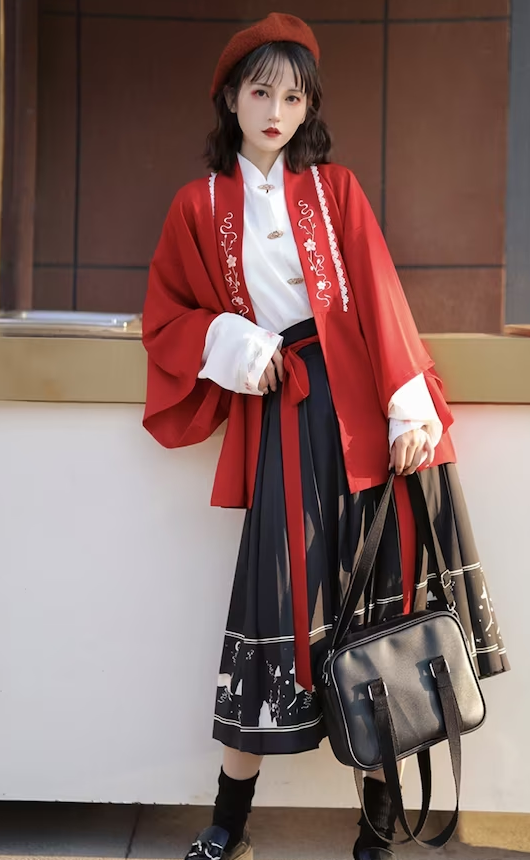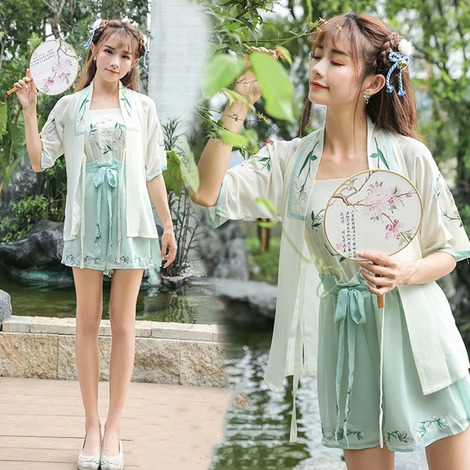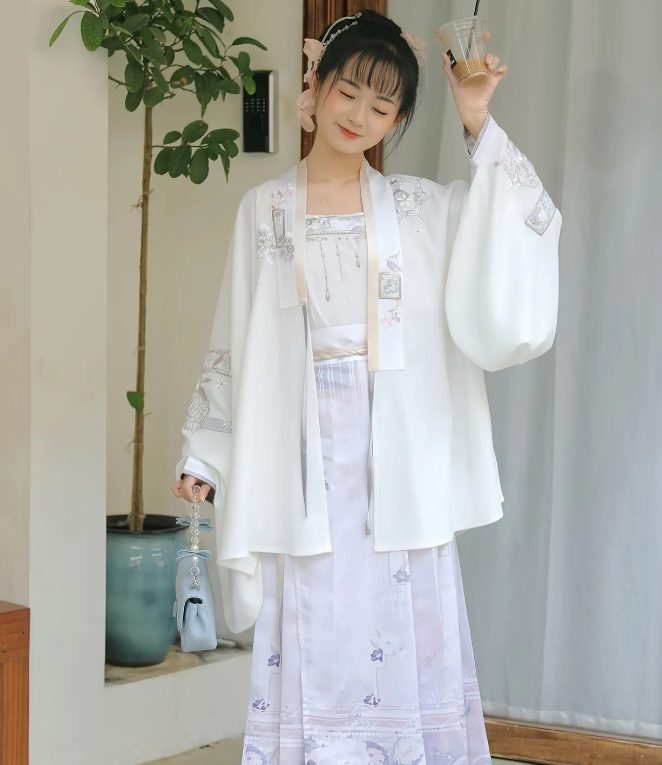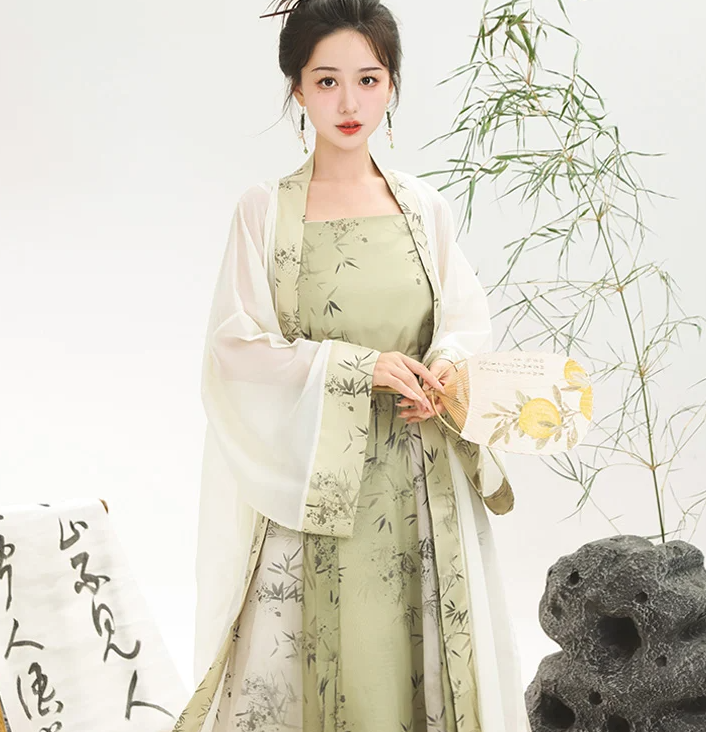You can wear Hanfu like Ruqun or Banbi, and pairing them with comfortable footwear and minimal accessories.
Understanding Different Types of Hanfu
The beauty of Hanfu lies in its versatility and the richness of forms it comes in. Understanding these various forms can help you make an informed choice when wearing Hanfu casually. Below are some common types of Hanfu you might consider incorporating into your casual wardrobe.

Ruqun (Skirt Sets)
Ruqun is a traditional Hanfu style that consists of a top and a skirt. For casual wear, you might choose a cotton or linen ruqun with simple patterns or solid colors. Pairing a ruqun with flat shoes or sandals makes it an excellent choice for a day out with friends or a casual walk in the park. You can also add a modern twist with some accessories like a contemporary belt or some ethnic jewelry.
Shenyi (One-piece Robe)
Shenyi is a one-piece robe that serves as both top and bottom, often reaching down to the ankles. While Shenyi can be formal, selecting one in a breathable fabric with simple designs can make it suitable for casual wear. Comfort is key when wearing Shenyi casually, so opt for natural fibers like cotton or linen. Since Shenyi offers a loose fit, it’s an ideal choice for both comfort and style. Complete your casual look with soft-soled shoes or slippers, and perhaps a simple hat for sunny days. Read more about its history and variations on Wikipedia.
Banbi (Half-arm Shirt)
Banbi is a short-sleeved, waist-length top that you can wear over a longer inner layer. It’s a perfect choice for transitional seasons like spring and autumn. Choose a Banbi in a neutral color to make it easy to mix and match with other clothing items. Since the Banbi often features intricate designs, you might want to keep the rest of your outfit simple for a casual look. Pair it with a long skirt or loose pants to create a relaxed but stylish outfit.
Zhiduo (Straight-hemmed Robe)
Zhiduo is a long robe with a straight hem, often worn by scholars in ancient China. Although traditionally more formal, you can adapt Zhiduo for casual wear by selecting one in lighter fabrics and less ornate designs. A cotton or linen Zhiduo in a solid color or simple pattern is versatile and can fit many casual settings. Pair it with some comfortable shoes and minimal accessories for a simple yet elegant look.
Materials Suitable for Casual Wear
Choosing the right material for your Hanfu can make a huge difference in comfort, especially if you’re planning to wear it casually. The fabric you select should offer breathability, flexibility, and a relaxed fit. Here’s a rundown of some of the best material options for casual Hanfu wear.
Cotton and Linen Hanfu
Cotton and linen are perhaps the most suitable materials for casual wear. Both of these natural fibers are breathable, allowing for good air circulation. Cotton is soft and flexible, which adds to the comfort level when you’re out and about. Linen, on the other hand, is known for its lightweight and breathable qualities. These features make it ideal for hot summer days. When opting for a casual look, choosing Hanfu made from cotton or linen can provide you with comfort without compromising on style. For more detailed information about fabric types, you might want to check this Wikipedia page.
Lightweight Silk
Silk, often associated with luxury and formality, can also be worn casually if you opt for lighter weights. Lightweight silk drapes well and gives off a soft luster, making it not overly formal. It’s also breathable and tends to regulate temperature well, which can be particularly useful in transitional seasons. Just remember that silk can be a bit more challenging to maintain, as it often requires hand-washing or dry cleaning. But the comfort and elegance it offers can be worth the extra care.
Blend Fabrics
Fabric blends, like cotton-silk or linen-rayon, offer the best of both worlds. These blended materials combine the benefits of their individual components, providing both comfort and durability. For example, a cotton-silk blend would give you the softness of cotton with the sheen of silk, making it a versatile choice for casual occasions. However, always check the fabric blend percentages as some blends may not offer the benefits of both materials equally.
Seasonal Considerations
When choosing Hanfu for casual wear, it’s crucial to consider the seasons, as weather conditions directly impact comfort and style. Each season presents its own set of challenges and opportunities for casual Hanfu wearers. Below, we delve into the best choices for different times of the year.
Summer Hanfu Choices
Summer demands breathable, lightweight fabrics to keep you cool and comfortable. Cotton and linen Hanfu are the top picks for this season. If you’re aiming for casual yet fashionable summer attire, a short-sleeved Ruqun or a sleeveless Banbi makes for a great choice. You can pair these with sandals or breathable canvas shoes to maintain the relaxed vibe. For more info on summer clothing and its history, have a look at this Wikipedia article.

Winter Hanfu Options
Winter requires materials that can retain heat and provide insulation. In this season, you may opt for Hanfu made from heavier silk or even wool blends. Shenyi and Zhiduo robes are good picks for winter, especially when layered over warmer undergarments. Pair your winter Hanfu with closed, comfortable shoes and perhaps add a decorative scarf or stole to maintain that traditional yet casual look. To learn more about winter garments, you can read this Wikipedia page.
Transitional Seasons
Spring and autumn are transitional seasons that call for more versatile wardrobe choices. Lightweight silk or blend fabrics are excellent choices during these times. A Banbi top over a long sleeve shirt or a Zhiduo robe in a lighter fabric can offer the flexibility you need to adapt to changing temperatures. Slip-on shoes or ankle boots can complete your casual Hanfu ensemble for these seasons.
Styling Tips for Casual Hanfu Wear
Choosing the right Hanfu and material is just the beginning. Styling your Hanfu outfit can add the finishing touches that transform it from a simple dress into a fashion statement. Below are some tips on how to perfect your casual Hanfu look.
Footwear Choices
When it comes to casual Hanfu, comfort should be your top priority, and footwear plays a significant role in this. For a relaxed look, flat-soled shoes like loafers or canvas sneakers can be a good fit. If you’re wearing a summer Hanfu, sandals might be your go-to for both comfort and style. For winter, consider leather or suede boots that can keep your feet warm. Traditional Hanfu shoes, such as “thousand-layer” soles, can also be an option if you want to keep an authentic touch. For more information on footwear, you might find this Wikipedia page informative.
Accessorizing Hanfu
Accessories can subtly enhance or dramatically transform your casual Hanfu look. For a day out, you might opt for a simple necklace or some hoop earrings. Hairpins or decorative combs can add a traditional flair to your outfit without making it overly formal. If you’re wearing a plainer Hanfu, a colorful belt or sash can add a pop of color and visual interest. Learn more about fashion accessories and their history on Wikipedia.

Layering Techniques
Layering is a great way to add dimension to your casual Hanfu outfit, especially during transitional seasons. A Banbi over a long-sleeve shirt, or a sleeveless vest over a Zhiduo, can make for a stylish yet casual look. The key is to keep the layers lightweight so as not to add bulk, and to choose colors and patterns that complement each other. Layering also allows you to mix materials, such as a silk top with a cotton bottom, to achieve a balanced and comfortable ensemble.
Everyday Occasions for Casual Hanfu
One of the great things about Hanfu is its versatility; you don’t have to reserve it for formal events or traditional celebrations. Many types of Hanfu lend themselves well to casual, everyday occasions. Below are some of the best opportunities for incorporating casual Hanfu into your regular routine.
Casual Social Gatherings
Whether it’s a low-key dinner with friends or a casual meetup at a café, Hanfu can be an excellent choice. A simple Ruqun or Banbi top paired with loose pants offers both comfort and style. It provides an excellent conversation starter and allows you to express your individuality. Lighter fabrics like cotton and linen are particularly suitable for such relaxed settings. You can also add a modern twist by accessorizing with some contemporary jewelry.
Outdoor Events and Festivals
Outdoor events like picnics, festivals, or even casual beach gatherings can be ideal venues for Hanfu. A lightweight silk or cotton Ruqun can be comfortable and easy to move in while keeping you looking stylish. If you’re attending an evening event, a Zhiduo in a blend fabric can keep you warm as the temperature drops. Just remember to wear comfortable shoes suitable for walking on grass or sand. For more on outdoor events and their cultural significance, you can refer to this Wikipedia article.
Everyday Wear and Running Errands
Believe it or not, Hanfu can also be practical for running errands or for casual everyday wear. Choose simpler designs with fewer layers for ease of movement and convenience. For instance, a short-sleeved Banbi with a pair of comfortable pants and sneakers could be an excellent outfit for a grocery store run or casual day out. Check out this Wikipedia page to read more about the evolution of casual wear over time.

Do’s and Don’ts of Casual Hanfu Wearing
Wearing Hanfu casually doesn’t mean you can throw caution to the wind. There are important considerations to keep in mind to ensure you’re respecting the cultural heritage of the attire while also meeting your own comfort and practicality needs. Here are some do’s and don’ts to guide you in wearing casual Hanfu appropriately and stylishly.
Cultural Sensitivity and Appropriateness
Do: Understand the significance and history of Hanfu. Being aware of its cultural context can help you wear it respectfully and appropriately.
Don’t: Use Hanfu as a costume or for purposes that may disrespect its heritage. It’s crucial to honor the cultural significance of Hanfu and not trivialize it.
For more about the cultural aspects of clothing, you can read this Wikipedia page on traditional Chinese clothing.
Comfort and Practicality
Do: Choose the right materials and styles based on your needs and the occasion. Cotton and linen are good options for hot weather, while silk or wool blends are better for colder seasons.
Don’t: Sacrifice comfort for style. Casual Hanfu should be practical and comfortable, so avoid overly elaborate designs or heavy fabrics when they’re not suitable.
Learn more about the ergonomics of clothing from this Wikipedia article.
Dress Code Observations
Do: Consider the dress code of the place you’re going to. If you’re attending a casual social gathering or an outdoor event, a simpler Hanfu design may be more appropriate.
Don’t: Disregard the dress codes or norms of different settings. While Hanfu can be a casual option, it might not be suitable for every occasion, like professional settings or formal events.
For more on dress codes and what they signify, check out this Wikipedia article.